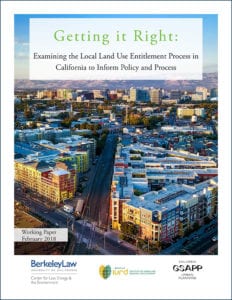Getting it Right: Examining the Local Land Use Entitlement Process in California to Inform Policy and Process
FEBRUARY 2018
*

California’s housing affordability crisis has rightly received a great deal of attention by state lawmakers, the press, academics, and ordinary Californians. Important questions raised in this discussion are: What laws or regulations might impede housing construction in high-cost areas? What solutions might help reduce those barriers with a minimum impact on other important values, such as environmental protection, public participation, and equitable treatment of low-income communities of color? More specifically, does state environmental law (the California Environmental Quality Act, CEQA), or local land-use regulations, constrain housing development?
To help answer that last question, we collected data on all residential development projects (of more than five units) over a three-year period in five Bay Area cities (San Francisco, Oakland, San Jose, Redwood City, and Palo Alto). We analyzed the law applicable to these residential development projects, including the local zoning ordinances, and interviewed important actors in the residential development process in each of these five cities.
We are collecting data and examining other cities in California now, but provide our findings from these first five below.
KEY FINDINGS
We found that these local governments are imposing discretionary review processes on all residential development projects of five or more units within their borders. That means even if these developments comply with the underlying zoning code, they require additional scrutiny from the local government before obtaining a building permit. This triggers CEQA review of these projects. In other words, what drives whether and how environmental review occurs for residential projects is local land-use law. Our data shows that in many cases, these cities appear to impose redundant or multiple layers of discretionary review on projects.
We also found that the processes by which local governments review residential development projects under their zoning ordinances and under CEQA varies from city to city. As a result, developers seeking to construct residential projects often must learn to navigate very different and complicated land-use systems, even if they work in the same region. This appears to particularly burden smaller development projects. Our data also shows that these cities rely on streamlined CEQA procedures for the majority of their residential projects, including many large projects. The effectiveness, however, of those streamlined procedures in terms of reducing timeframes for project approval varies greatly from city to city, indicating that a range of non-legal factors (such as practices in planning departments, or the amount of resources dedicated to planning) may impact development timelines.
Finally, our own research process also revealed that the kind of project level data that we collected, while essential to crafting effective solutions to the California housing crisis, is not easily available. We therefore recommend that the legislature develop a consistent and uniform data reporting pro-gram for this data, which will benefit policymakers, developers, and the public as a whole.
*
IMMEDIATE POLICY RECOMMENDATIONS
The value of improving access to good data cannot be overstated. Although top-down state reform of environmental regulations (or local regulation over land use) may encounter substantial difficulties, something the state could do now would be to provide guidance to jurisdictions on how to provide better access to accurate project-specific data on land use approvals, and require all jurisdictions to maintain relevant data in a central repository.
Though all our five cities make efforts to provide access to project approval data, this access could be greatly improved by providing the information in a centralized repository that uses consistent terminology across jurisdictions. To the extent that processes are so dissimilar that they cannot be analogized, this centralized repository should contain explanations. Smaller steps would also be welcome. Linking existing geographic information systems (GIS) or zoning data with assessor parcel information and building permit systems, for example, would be a great first step, particularly because housing element law at the time only required annual reporting based on building permits issued not numbers of units entitled. In our experience, it is not always easy to cross-check housing element reporting obligations with building entitlements because not everything that gets entitled is immediately built. Linking these systems to provide this data could make housing element reporting more robust.
No comments:
Post a Comment